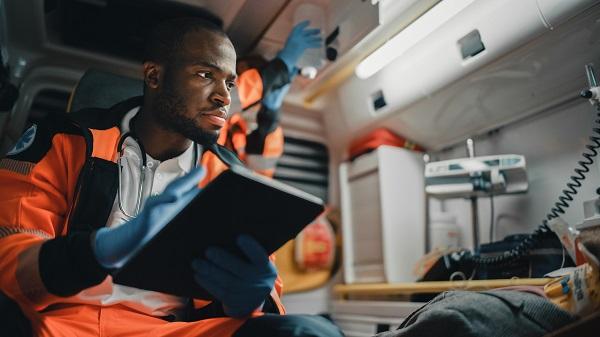STEMI App Lowers Time to Treatment Across Regional Health System
Replacing a radio-based system, the smartphone app enables EMS to send text, photos, video, and vitals directly to the ED.

The implementation of a smartphone-based application to aid with communication about STEMI patients coming in from the field has enabled one large health system to drop its EMS-to-balloon time by 10 minutes, according to a new study.
“With this device you can send text, pictures, video, vitals, and it not only goes to the ED but a whole system,” senior researcher Amir Lofti, MD (Baystate Medical Center, Springfield, MA), told TCTMD. “All that information is communicated to a group of people that is preselected and therefore everybody is on the same page. Everybody knows there's a patient coming, you have real-time GPS location so they know exactly how far the patient is out, they know when the patient arrives from the rig, and we know their clinical status or if their clinical status changes. So we're all prepared for them in the ED and then the cath lab.”
Prior to their adoption of the Wi-Fi-based, HIPAA-secure, GPS-enabled e-Bridge app (General Devices) in May 2019, the team used a less reliable radio-based system, said Alina Capatina, MSN (Baystate Medical Center), who will be presenting the results as a poster next week during the American College of Cardiology (ACC) 2021 Scientific Session.
“It worked for point-to-point communication, but it didn't work too well for communication between EMS and our cath lab for activated STEMI and loop communication and especially follow-up in the case of patients deteriorating or clinical statuses changing after the radio report was concluded,” she told TCTMD. “The other thing was it was very limited in its range. So if EMS uses the basic radio system, they're not able to call in unless they are like 5 minutes out from the hospital. We have a huge catchment area of patients coming from upwards of an hour, 2 hours away. So the earlier that we can get these alerts, obviously the better in order to prepare.”
For the study, the researchers looked at a total of 795 STEMI cases coming to their institution between January 2017 and July 2020.
Among the 424 patients who remained after those who were transferred to other institutions, had contraindications to PCI, or received thrombolytics were excluded, 82 were treated after the implementation of the app. There were reductions in both EMS-to-balloon time (90.8 vs 99.4 minutes; P = 0.0062) and door-to-balloon time (56.3 vs 67.8 minutes; P < 0.0001) following the change in communication system.
Improved a ‘Well-Functioning System’
“We were hoping that this app would do what we wanted to do, but we were surprised by the magnitude of it,” Lofti observed, adding that the collaboration and hard work within his team and alongside EMS were vital to their success.
Notably, he continued, “we already had a well-functioning system. If you look at our door-to-balloon times prior to the implementation, they were one of the best from [a National Cardiovascular Data Registry] perspective. This only enhanced and made the system better. . . . If your system is not working well to begin with, this is not going to magically change that. It really takes a commitment from the team to make this work.”
Capatina agreed. “Seeing such a significant improvement in our time was a little bit surprising,” she said. “But with the hard work of everybody who was involved and gaining everybody's buy-in and just having a massive team that was dedicated to implementing this project and implementing all of the changes and monitoring the outcomes, looking back on that and seeing the outcomes now is kind of not as surprising as one might expect.”
The initial integration was not without its challenges, Capatina explained. “With any application, there are always glitches and technical issues. When we first launched, even though we ran hundreds and hundreds of test cases, we did run into some glitches that we had to literally fix in real time.”
EMS was also initially concerned about the extra time it might take to fill out information in the app, Lofti said. “But by working with them, we created drop-down boxes that are very easy, so each patient might take only 1 or 2 minutes for them to put in the information and send it to the emergency department. We made it very user-friendly for them.”
Lofti said one of the main selling points of this particular app, as other options were available, was the customizability to their particular needs. Now, their institution uses the same app for trauma, stroke, cardiac arrest, general medical, and COVID-19 patients.
As for the cost, though the health system provides the app free of charge to EMS, they pay a licensing fee. “When we compared the cost of this application to the potential benefit, we saw a huge value in it, especially when we projected potential effects on patient outcomes,” Capatina said.
Lofti said they plan to continue researching how this app can improve their care for patients with STEMI as well as cardiac arrest, given their time sensitivity. “There are many possibilities, including extracorporeal life support,” he said.
Yael L. Maxwell is Senior Medical Journalist for TCTMD and Section Editor of TCTMD's Fellows Forum. She served as the inaugural…
Read Full BioSources
Capatina A. Reducing EMS-to-balloon time: there’s an app for that. Presented at: ACC 2021. May 15, 2021.
Disclosures
- Capatina and Lofti report no relevant conflicts of interest.





Comments